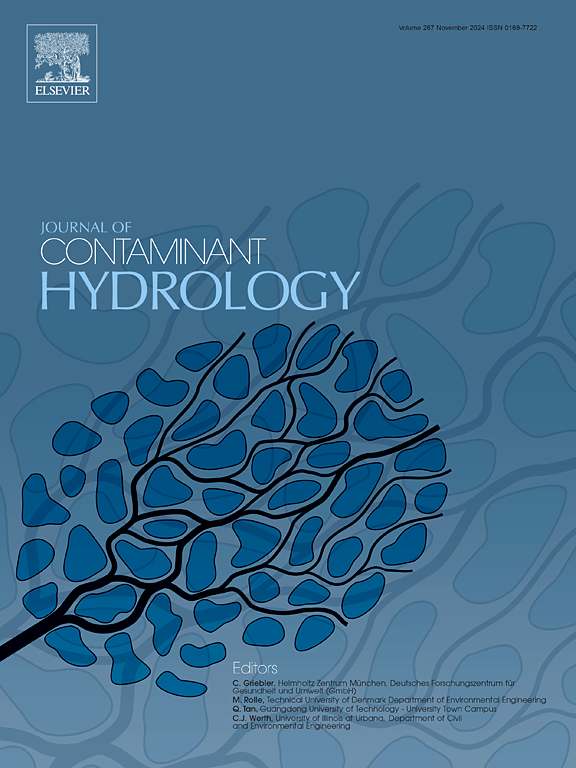综合水质评估和循环模型对战略碳酸盐系统的可持续管理:来自尼龙山的线索。卡特里亚山脊(意大利中部)
IF 4.4
3区 环境科学与生态学
Q2 ENVIRONMENTAL SCIENCES
引用次数: 0
摘要
本研究提供了最新的奈龙山水文地球化学特征和环流模式。Catria碳酸盐岩山脊(NCCR)地下水系统是意大利马尔凯地区佩萨罗-乌尔比诺省约36万居民的重要水资源。对大量水样的化学分析表明,它们具有相对较低的总溶解固体(TDS < 400 mg/L)的Ca-HCO3组成,表明与周围碳酸盐和硅酸盐的相互作用有限,通道短而浅。一些样品显示so4富集和较高的TDS(高达3350 mg/L),可能与相对较深的流动路径与蒸发三叠纪Burano地层相互作用有关,而一些Na-HCO3 (TDS高达1000 mg/L)的水的存在表明在富na的陆源地层中循环时间延长。化学水质指数(CWQI)证实,大多数NCCR水质良好,因为人为污染几乎可以忽略不计,硝酸盐和氯化物含量低。然而,少数矿化弹簧显示高CWQI值,表明质量差。后者通常沿主要断裂系统发生,并在不同程度上与低盐度的浅层Ca-HCO₃水混合。这意味着过度开采地下水可能会抽走矿化水,从而增加水质恶化的风险。本研究强调了持续监测和可持续管理措施对保护NCCR资源的重要性,特别是在气候变化和人为压力增加的影响下。我们的综合水文地球化学方法和水循环的概念模型为地下水动力学提供了有价值的见解,它可以应用于世界各地类似的(岩溶)系统。本文章由计算机程序翻译,如有差异,请以英文原文为准。
Integrating water quality assessment and circulation models for a sustainable management of a strategic carbonate system: Clues from the Mt. Nerone-Mt. Catria Ridge (Central Italy)
This study provides an updated hydrogeochemical characterization and circulation model of the Mt. Nerone-Mt. Catria carbonate ridge (NCCR) groundwater system, a vital water resource for the ∼360,000 inhabitants of the Pesaro-Urbino province (Marche Region, Italy). Chemical analyses of an extensive dataset of water samples revealed that they exhibit a Ca-HCO3 composition with a relatively low Total Dissolved Solids (TDS < 400 mg/L), suggesting limited interaction with the surrounding carbonates and silicates, and short and shallow pathways. A few samples show SO4-enrichments and higher TDS (up to 3350 mg/L), likely related to relatively deep flow paths interacting with the evaporitic Triassic Burano formation, while the presence of some Na-HCO3 (TDS up to 1000 mg/L) waters suggests prolonged circulation within Na-rich terrigenous formations.
The Chemical Water Quality Index (CWQI) confirms that most NCCR waters are qualitatively good since the anthropogenic contamination is practically negligible, as testified by the low contents of nitrate and chloride. Nonetheless, a few mineralized springs display high CWQI values, indicating poor quality. The latter usually occur along the main fault systems and mix, at different degrees, with the low-salinity shallow Ca-HCO₃ waters. This implies that excessive groundwater exploitation might be able to pump the mineralized waters, thus increasing the risk of quality deterioration. This study underscores the importance of continuous monitoring and sustainable management practices to preserve the NCCR resource, especially under the effects of climate change and increasing anthropogenic pressures. Our integrated hydrogeochemical approach and the conceptual model of water circulation offer valuable insights into groundwater dynamics, and it can be applied to similar (karstic) systems worldwide.
求助全文
通过发布文献求助,成功后即可免费获取论文全文。
去求助
来源期刊

Journal of contaminant hydrology
环境科学-地球科学综合
CiteScore
6.80
自引率
2.80%
发文量
129
审稿时长
68 days
期刊介绍:
The Journal of Contaminant Hydrology is an international journal publishing scientific articles pertaining to the contamination of subsurface water resources. Emphasis is placed on investigations of the physical, chemical, and biological processes influencing the behavior and fate of organic and inorganic contaminants in the unsaturated (vadose) and saturated (groundwater) zones, as well as at groundwater-surface water interfaces. The ecological impacts of contaminants transported both from and to aquifers are of interest. Articles on contamination of surface water only, without a link to groundwater, are out of the scope. Broad latitude is allowed in identifying contaminants of interest, and include legacy and emerging pollutants, nutrients, nanoparticles, pathogenic microorganisms (e.g., bacteria, viruses, protozoa), microplastics, and various constituents associated with energy production (e.g., methane, carbon dioxide, hydrogen sulfide).
The journal''s scope embraces a wide range of topics including: experimental investigations of contaminant sorption, diffusion, transformation, volatilization and transport in the surface and subsurface; characterization of soil and aquifer properties only as they influence contaminant behavior; development and testing of mathematical models of contaminant behaviour; innovative techniques for restoration of contaminated sites; development of new tools or techniques for monitoring the extent of soil and groundwater contamination; transformation of contaminants in the hyporheic zone; effects of contaminants traversing the hyporheic zone on surface water and groundwater ecosystems; subsurface carbon sequestration and/or turnover; and migration of fluids associated with energy production into groundwater.
 求助内容:
求助内容: 应助结果提醒方式:
应助结果提醒方式:


